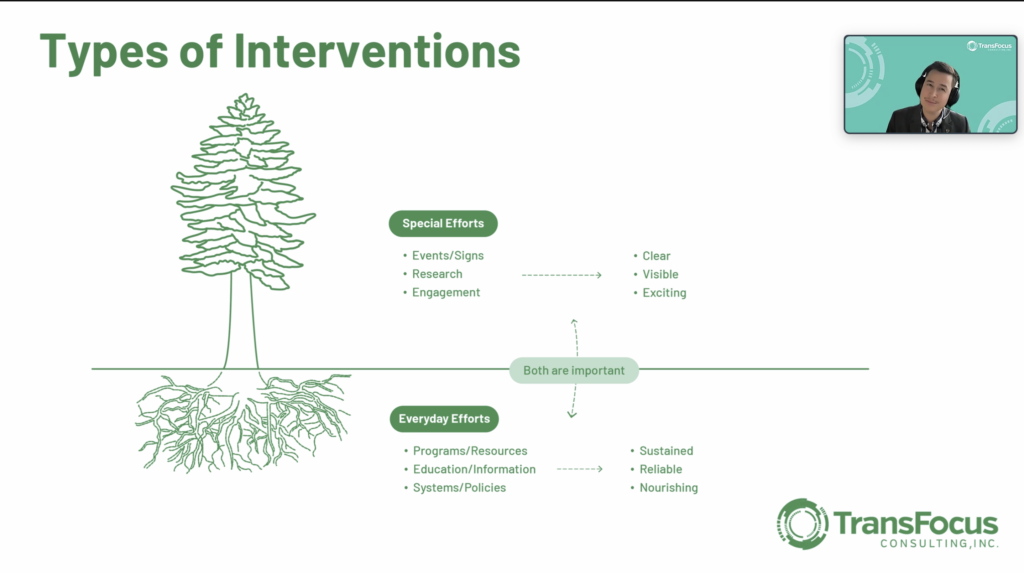This blog post is based on a November 2023 webinar by Kai Scott, President and Gender Strategist at TransFocus, a consultancy focused on assessing and organizational issues related to gender diversity. For more information on TransFocus, including their four-module workshop on gender inclusivity in the workplace, visit www.transfocus.ca.
Research shows that trans and non-binary people experience a range of barriers and challenges, from subtle (such as assumptions about their identity or sexual orientation) to overt (including discrimination and violence).
These challenges have been exacerbated by recent, much-reported conflicts around gender-affirming care for youth. Small but vocal groups have developed targeted messaging to undo current progress toward trans inclusion. They often advance claims – about gender education in schools and statistics of gender transition among youth – that are misleading and false. In the general public, many people are left with a lack of awareness, as well as with genuine questions and few places to have them answered.
Trans allies, in this context, must build their understanding of the issues in order to respond to misconceptions of transgender people, including in the workplace. To do so, suggests Kai Scott, allies should (1) learn terms and concepts, (2) understand the legal context, (3) be aware of everyday challenges that trans people face, and (4) respond to difficulties in everyday situations with kindness and patience.
1. LEARN TERMS AND CONCEPTS
“It’s OK to talk about differences,” says Scott. “It’s how you do that that’s important.”
Trans allies and colleagues should educate themselves regarding key terms and inclusive understandings related to gender.
In this context, it is important to note that sex at birth, gender identity, and gender expression each exist on their own spectrums; where individuals might be on these spectrums is distinct and individual. It is important to avoid making assumptions about where people lie on these spectrums.
For more information, please visit “Glossary of Terms: Transgender” (from the US-based LGBTQ+ advocacy organization, GLAAD).
2. UNDERSTAND THE LEGAL CONTEXT
Between 2012 and 2017, “gender identity and expression” were added as protected grounds in provincial human rights codes; in June 2017, the same terms were added within the Canadian Human Rights Act. In other words, discrimination on grounds of gender identity and expression are now prohibited under Canadian human rights law.
What does this protection mean? The law continues to be clarified in court cases. The case law, for example, supports the right of trans people to use the washroom that matches their lived gender identity (without asking). The right to be called by pronouns that match lived gender identity, too, is protected by law.
For more information, please see this “backgrounder” on gender identity and gender expression from the Ontario Human Rights Commission.
3. BE AWARE OF THE EVERYDAY CHALLENGES TRANS PEOPLE FACE
Trans and non-binary people face a range of challenges and barriers, from the interpersonal to the social and political.
Statistics from TransPulse Canada on British Columbia show the effects of overt, structural challenges on the livelihoods and well-being of trans people in this province:
- In BC, trans people are three times more likely to face unemployment than the general population.
- In BC, 39 percent of trans households are low income, versus 12 percent of the general population.
- In BC, 45 percent of trans people report having “unmet health needs,” versus 9 percent of the general populati in on. (For trans people, these “unmet needs” are for both general healthcare and trans-specific care.)
In the workplace, LGBTQ employees face discrimination and violence. A 2022 study by the Canadian Labour Congress found that almost three quarters of gender diverse respondents have faced sexual harassment and violence at work (see Harassment and Violence in Canadian Workplaces). Challenges include hearing negative jokes, comments, or slurs or responding to inappropriate curiosity.
In the webinar, Scott shared quotes demonstrating the effects of bias and anti-trans discrimination on trans employees:
“I changed jobs from a higher-paying one where I was not comfortable being out as a trans person to a much lower-paying one where I felt my identity would be respected.”
“Coworkers would gossip about me as news about my trans status spread through the workplace. I was treated significantly differently once people heard about me being trans. I became a spectacle in my own workplace.”
In the workplace, says Scott, “People have to navigate some pretty untenable circumstances and have to make tough trade-offs to be in a better situation and take care of themselves.”
For an overview of anti-trans discrimination in the workplace, see “Creating a Trans-Inclusive Workplace” (from the Harvard Business Review, March–April 2020).
4. RESPOND TO DIFFICULTIES IN EVERYDAY SITUATIONS WITH KINDNESS AND PATIENCE
“What can I do as an individual?” This is a question Scott is regularly asked. He identifies two main types of interventions: special efforts and everyday efforts (see figure 1).

Both types of interventions are important, says Scott, but having strong root systems can really help: “Those everyday actions that seem simple or small actually do over the long time create sustained change,” he says.
Examples of everyday efforts include using first names and pronouns that trans people share and pausing to reflect before assuming a person’s pronouns or asking a question related to gender identity or expression. You can build your knowledge through research, rather than by burdening someone with your need for information.
Everyday efforts can also include intervening with others, such as by addressing jokes or disparaging comments (saying, for example, “I don’t find that funny” or “This is not appropriate at work”), explaining your views, or providing resources or information. When intervening, suggests Scott, you should avoid shaming or blaming people.
SUMMARY: A TIME FOR SUPPORT
Allyship and the correction of myth and misinformation are critically important at this time of risk for trans and non-binary people. Research shows, for example, that the effects of adult support on youth is transformative: one caring adult can result in drastic improvements in mental health for youth and a significant decrease in suicidal ideation.
In the workplace, support for trans coworkers and clients may involve a lot of self-reflection and learning. Also important are patience and the presence of mind to avoid jumping in or making assumptions.
“Given all the disempowerment that’s going on,” says Scott. “It’s important to empower folks by giving them the freedom to show up as much or as little as they like, by giving them the lead.”
REFERENCES AND RESOURCES
Canadian Human Rights Act: https://laws-lois.justice.gc.ca/eng/acts/h-6/
Canadian Labour Congress: Harassment and Violence in Canadian Workplaces: It’s [Not] Part of the Job.
https://documents.clcctc.ca/human-rights/Respect-at-Work-Report-EN.pdf
Christian N. Thoroughgood, Katina Sawyer, and Jennica R. Webster. 2020. Creating a Trans-Inclusive Workplace. Harvard Business Review. https://hbr.org/2020/03/creating-a-trans-inclusive-workplace
GLAAD. “Glossary of Terms: Transgender.” GLAAD Media Reference Guide. https://glaad.org/reference/trans-terms/
Ontario Human Rights Commission. Backgrounder: Talking about Gender Identity and Gender Expression. https://www.ohrc.on.ca/en/backgrounder-%E2%80%93-talking-about-gender-identity-and-gender-expression
TransPulse Canada: https://transpulsecanada.ca/
Statistics Canada: Age, Sex at Birth and Gender Reference Guide, Census of Population, 2021. https://www12.statcan.gc.ca/census-recensement/2021/ref/98-500/014/98-500-x2021014-eng.cfm

















